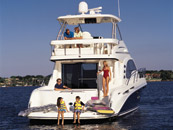Nothing odd about taking your dog out boating with you. You just need to think about it ahead of time and prepare.
For starters, dog- or puppy-proof your boat. Look around for things your dog could get into and possibly get hurt on. If you fish from the boat, check to make certain your gear is stowed safely away; bait and tackle securely contained — as far as dogs are concerned some types of bait are delectable. Fishing hooks can be excruciating to remove, so be absolutely sure they are kept someplace where curious noses and paws can’t impale themselves while investigating.
Be sure to provide an area for your dog’s toilet needs. Either invest in one of those port-a-potty set ups for dogs or make your own version that will hold a puppy pad or newspapers securely in place. It can get windy out on a boat and papers or pads can all too easily get blown away. Keep a supply of plastic waste disposal bags on board as well and a small waste bucket with a lid that seals tightly.
Have plenty of drinking water stowed on board— more than you expect to need. Take care to ensure your dog doesn’t become dehydrated. Being out on the water can bring on a raging thirst—after all it’s usually a warm day in the sun. Look for a water bowl that won’t slide around and is somewhat self-leveling; It doesn’t do much good to put out water for your dog if it’s going to slide around and slosh out all over before your dog gets a chance to drink.
Purchase a properly fitted personal flotation device for your dog — one with a handle attached to the back so you can pull him out of the water if necessary. Take the time to get him used to wearing it before you bring him on board. A PFD is very alien to any dog, so it’s important to let your dog get acquainted with his before you introduce him to the rest of the anomalies of life on a boat.
That brings us to actually getting the dog onto the boat. There are special steps and ramps made that can take the leap of faith aspect out of getting your dog on board, allowing him to simply walk from the dock to the deck with a little practice.
Let your dog get used to walking around on the boat before you take it out onto open water. The deck of a boat is nothing like terra firma. You probably had trouble keeping your balance the first time you were on a boat, and you can expect your dog to have some of the same issues. Better to have you dog get over any fright at the dock or while the boat is still sitting in your backyard on the trailer than when you’re out in the middle of the channel or out on the open water.
In your first aid kit, be sure to pack a “just in case” supply of Dramamine or whatever your veterinarian prescribes for motion sickness. Stow something to clean up vomit as well.
A very important piece of “just in case” equipment is a sturdy boat hook, one with a sturdier one-piece handle rather than a telescoping handle that can bend or break under load. While you’re getting your dog acclimated to his PFD, get him used to being “hooked” as well, so that if you should ever need to use it in an emergency that long stick coming at him won’t terrify him and cause him to shy away in a panic.
There are quite a few steps to getting your dog ready to be your first mate, but most are common sense. Use your head and you can look forward to many happy nautical miles in each other’s company.
Article provided by Ellie Brown of http://www.pet-super-store.com . Where you can find great deals on Dog Steps and Dog Crates.


